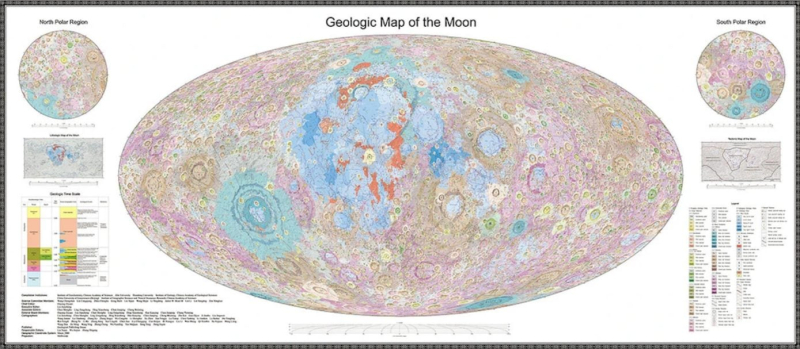
© Ganapathy Kumar/Unsplash
The result of more than a decade of international collaboration under the aegis of the Chinese Academy of Sciences (CAS), this new map is a major scientific tool. With unequaled precision, it will greatly facilitate the understanding of our star and help exploration and future lunar missions. A titanic work which will have required no less than 100 researchers gathered around this Herculean project in order to see it through. Called Geologic Atlas of the Lunar Globe, this cartography is in reality a set of several maps, revealing the Moon in all its smallest details.
An international collaboration project
Revealed in the journal Nature, this atlas monumental « reveals a total of 12,341 craters, 81 basins, and 17 rock types, as well as other basic geological information about the lunar surface. The maps were produced at the unprecedented scale of 1:2 500 000 ”. A true scientific treasure.
It was created by bringing together a multitude data from not only the Chinese Chang’e lunar missions, but also other international missions. NASA's Lunar Reconnaissance Orbiter and India's Chandrayaan-1 observations in particular.
This atlas is a very valuable document for space science and opens new opportunities, allowing deeper and more fruitful exploration of our natural satellite. Scientists around the world now have a valuable tool to identify new areas of interest, plan future missions and examine the Moon from every angle.

© Chinese Academy of Sciences via Xinhua/Alamy
A technological and strategic advance
The feat is remarkable from a technical point of view, but it reveals another reality. China wants to position itself as a leading scientific and technological superpower for decades to come. As Ross Mitchell, geophysicist at CAS, pointed out, if these maps are intended to “ benefit the whole world ” , they also contribute to the advancement of lunar science, allowing China to “ consolidate its potential role as a major scientific power ”. One (big) stone, two blows.
The establishment of this atlas comes at a pivotal moment when the race to establish permanent bases on the Moon is increasingly intensifying. China and Russia, in particular, aspire to play an active role in the project to build an International Lunar Research Station near the lunar South Pole< /strong>.
This mapping project is also the tangible symbol of China's growing scientific ambition and perfectly demonstrates that the country is fully capable of tackling complex scientific challenges. From now on, there is no doubt that it will play a leading role in space exploration of the 21st century.
Global implications of the project and the ;access to information
The completion of this project also marks the beginning of a new era: that of by the democratization of access to lunar geological information. The Geologic Atlas actually constitutes the central element of an even larger work entitled Map Quadrangles of the Geologic Atlas of the Moon. This brings together not only detailed maps of the Moon, but also 30 sector diagrams offering even more in-depth views of specific lunar regions. They can, for example, show craters, mountains, valleys or other important geological formations.
These works will soon be available online at international community of researchers via the Digital Moon platform. An initiative that will facilitate collaboration and collectivization of knowledge on a global scale, allowing scientists around the world to access accurate and up-to-date data on lunar geology.
This approach represents a radical change from previous practices, where access to such information was often restricted to a restricted circle of researchers or institutions. Now, lunar research will benefit from a greater diversity of expertise and perspectives. A completely new opening, especially since these data will be consultable by anyone, civil society included. A very beautiful project, both symbolically and scientifically.
- China has developed the Geologic Atlas of the Lunar Globe, offering a detailed view of the Moon with maps on an unprecedented scale
- A project used by the country to assert its status as a scientific power, but also to facilitate future lunar missions.
- These maps will soon be accessible worldwide via the Digital Moon platform, thus promoting scientific collaboration on a global scale.
📍 To not miss any news from Lemon squeezer, follow us on Google News and WhatsApp.
[ ]

